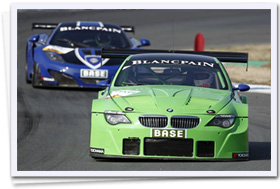Based on commercial available two door sport models, the FIA GT3 cars are modified race versions produced by the manufacturers themselves or their approved tuners and then homologated by Federation Internationale de l'Automobile.
When you have a variety of participating car models in a race category, the issue of performance gap between them always arises. For the FIA GT3 cars, however, the Federation coordinates it as the neutral party by setting out the minimum weight or the size of air restrictor for each car models and homologating the car under the specified conditions. This gives equal opportunities to fight for race wins to many car models, even if there are considerable performance gaps between their base models, and encourages more manufacturers to participate. The resulting level playing field is the most significant feature of the FIA GT3 race series.

Race series using the FIA GT3 cars are increasing worldwide recently and the ADAC GT Masters is the German version of them. ADAC stands for Allgemeiner Deutscher Automobil-Club e.V. and is the German national motor sport sanctioning authority - Authority Sport Nationale or ASN - appointed by FIA which is the international sanctioning body of ASNs under its umbrella. And its GT-Masters series has been a very successful championship which attracts more than 40 participants in almost every race meeting since its foundation in 2007. The races are broadcasted live in TV and there is a huge number of followers not only in Germany but throughout the European continent.
One of the main appeals of the series is, as mentioned above, a wide variety of participating car models and the manufacturers of them includes Alpina, Ascari, Aston Martin, Audi, BMW, Chevrolet, Dodge, Ferrari, Ford, Lamborghini, McLaren, Mercedes Benz, Porsche and even Nissan from Japan. So every race meeting becomes a glamorous gathering of a load of iconic sport cars.
Each race event consists of two 60 minute races and two drivers team up to drive their car in one race each. The driver lineup includes ex-formula one pilots or well-known names in other high level categories such as DTM - Deutsche Tourenwagen Masters - but, as a unique feature of this series, a professional race driver must share the car with an amateur racer.
The championship point system is identical with that of Formula One or the FIA World Touring Car Championship, which means that 25 points for the winner, 18 for the runner-up, etc and the tenth place finisher takes the final point. Other than the championship for driver pairs, the titles for teams and amateur drivers are also hotly fought.
The 2012 calendar starts with the Oschersleben round in early April and the eight round series tours around the major German race tracks with a couple of exceptions, Zandvoort in Netherlands (Round 2) and Red Bull Ring in Austria (Round 5), and visits Nurburgring, which is very well known for its annual 24 hours race, twice in July and September.